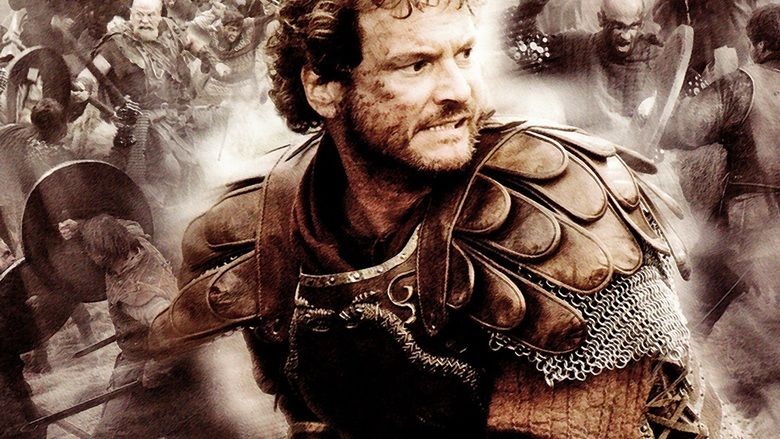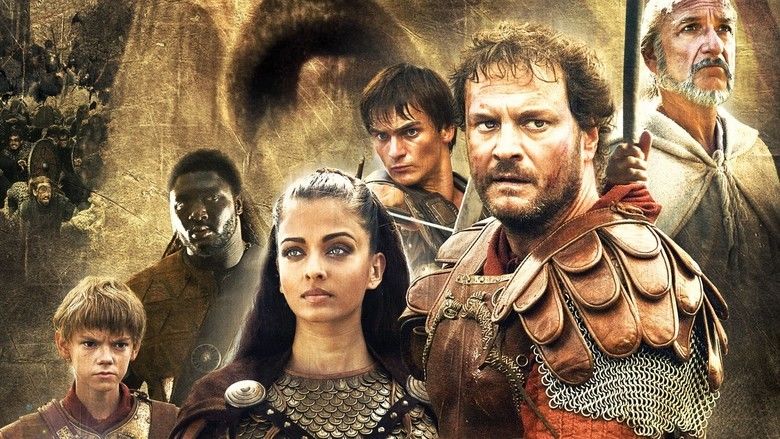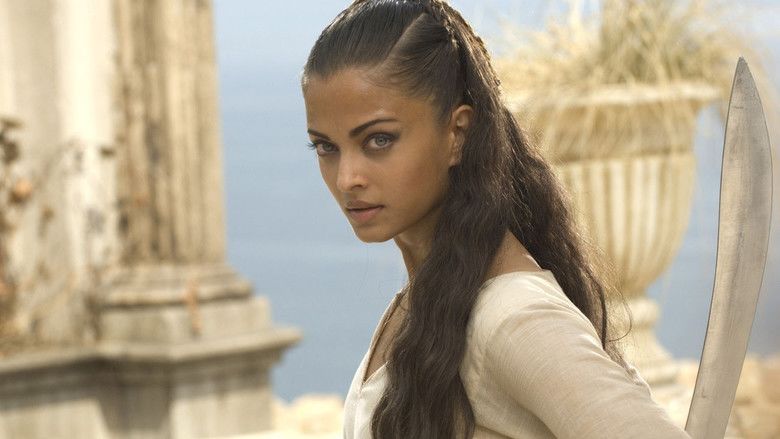The Last Legion
3.6 /10 1 Votes
16% Rotten Tomatoes Language English | 5.4/10 IMDb 37% Metacritic Genre Action, Adventure, Fantasy Duration Country ItalyUnited KingdomFranceSlovakia | |||||||||||||||||||||||||||||||||
 | ||||||||||||||||||||||||||||||||||
Release date April 6, 2007 Screenplay Jez Butterworth, Tom Butterworth Cast (Aurelius), (Ambrosinus), Aishwarya Rai Bachchan (Mira), (Odoacer), (Wulfila), (Nestor)Similar movies Asterix & Obelix take on Caesar , Gladiator , Asterix the Gaul , Asterix at the Olympic Games , Asterix vs. Caesar , Spartacus Tagline The end of an empire...the beginning of a legend. | ||||||||||||||||||||||||||||||||||
The last legion 2007 official trailer 1 ben kingsley movie hd
The Last Legion is a 2007 action adventure film directed by Doug Lefler. Produced by Dino De Laurentiis and others, it is based on a 2002 Italian novel of the same name written by Valerio Massimo Manfredi. It stars Colin Firth along with Sir Ben Kingsley and Aishwarya Rai, and premiered in Abu Dhabi on 6 April 2007.
Contents
- The last legion 2007 official trailer 1 ben kingsley movie hd
- The last legion trailer aishwarya rai battle scene
- Plot
- Cast
- Reception
- Differences from the novel
- Connections to Arthurian legend
- Excalibur
- Connections to other films
- References

The film is loosely inspired by the events of 5th-century European history, notably the collapse of the Western Roman Empire. This is coupled with other facts and legends from the history of Britain and fantastic elements from the legend of King Arthur to provide a basis for the Arthurian legend.

The last legion trailer aishwarya rai battle scene
Plot

The film is narrated by Ambrosinus, native to Britain, who knows of a legend concerning the sword of Julius Caesar, which was hidden away from evil men. It begins shortly before the coronation of Romulus Augustulus as Emperor in 475.

Having travelled through much of the known world in search of Caesar's sword, Ambrosinus has then become the tutor to the young Romulus. A Druid and part of a secret brotherhood protecting the sword, he at times gives the impression he is a magician, but his "magic" is usually revealed to be simple trickery. One of the running concepts of the movie surrounds the question of whether or not Ambrosinus has any actual magical abilities or simply an illusionist. Romulus's father Orestes rules Rome but is not Emperor himself.

On the day before the coronation, Odoacer, commander of the barbarian Goths allied with Rome, demands a third of Italy from Orestes, but is rebuffed. The same day, Romulus meets the general of the Nova Invicta Legion, Aurelianus Caius Antonius, called "Aurelius".

The night after Romulus is crowned, Rome is attacked by the Goths. Most of Aurelius's men, pledged to protect the emperor, are killed, though Aurelius is only stunned and left for dead. Orestes and his wife are killed by Odoacer's lieutenant Wulfila, who captures Romulus.

The next day, Odoacer, now ruler of the Western Empire, plans to have Romulus killed. However, Ambrosinus convinces Odoacer to spare the boy. Instead, Romulus is exiled to Capri along with Ambrosinus, guarded by Wulfila and his men. His prison is a villa constructed more than four centuries earlier by the emperor Tiberius.
With Ambrosinus's help, Romulus discovers a hidden chamber within the villa. He comes across a statue of Caesar holding the fabled sword, forged by a Chalybian smith after his military campaigns in Britain. Writing near the statue's feet proclaims the sword was made for "he who is destined to rule". This is interpreted as a prophecy by various characters, and Romulus keeps the weapon.
The two are rescued from Capri by the loyal Aurelius and three surviving legionaries, Vatrenus, Batiatus, and Demetrius, accompanied by a female agent of the Eastern Roman Empire – a warrior named Mira. They take Romulus to a seaport where the Eastern Roman Empire's emissary (whom Mira works for) and the senator Nestor have promised safe passage to Constantinople. However, they barely escape after they learn the Senate and the Eastern Empire have betrayed them and sided with Odoacer.
Ambrosinus persuades Romulus to seek refuge in Britain, where the Ninth Legion (called the Dragon Legion) may remain loyal, being far from the events. They are followed by Wulfila and his men; the Goth covets Caesar's sword after learning the prophecy. Crossing the Alps and the English Channel, the party travels to Hadrian's Wall and initially find no evidence of the legion until a farmer approaches and reveals he was its commander. With the collapse of Roman support of Britain, the legion had decided to disband and settle as farmers. Most of the men in the legion had married and had families. They also did not want to antagonise the powerful warlord Vortgyn. During their stay in the small Celtic village, Romulus meets and befriends a young girl named Igraine. Aurelius and Mira practice swordfighting and become close to each other. Ambrosinus told Romulus of a scar on his chest, similar to the design on the sword hilt, which he received from Vortgyn after he refused to tell him where the sword of Caesar was.
Vortgyn also desires the sword of Caesar as he aspires to rule the whole of Britain. It is revealed that Vortgyn and Ambrosinus are old enemies. After meeting with the Goths, Vortgyn decides to either capture or kill Romulus as a gesture to Odoacer. After confronting Igraine outside of the village, he convinces her to tell everyone in the village to surrender Romulus and has several of his men kill the blacksmith's wife and sons. When a tearful Igraine tells the villagers of what has happened, Aurelius confesses that Romulus is the emperor of Rome. The blacksmith then demands revenge on his wife's and sons' deaths, and Aurelius and his men decide to lead an army to Hadrian's Wall to face Vortgyn's armies in one final battle.
Before leaving the village, Romulus receives from Igraine a suit of Roman armour which belonged to her brother, which he has since outgrown. Aurelius, wielding Caesar's sword, leads his men and a small number of Celtic warriors against Vortgyn's forces at Hadrian's Wall. Aurelius, his men, and the archers pelted the infantry with arrows, while Mira, Romulus, and several Roman and Celtic soldiers struggled to hold the enemy at the gate. Despite their casualties, Vortgyn's soldiers began to slowly overwhelm the small force on the wall. The battle appears hopeless until the rest of the Ninth Legion, having taken up their old Roman arms and uniforms, appear and turn the tide. The two warring sides cease their hostilities when Ambrosinus confronts and burns Vortgyn alive at a tree-sanctuary of his secret brotherhood near the battlefield.
After having fought and severely injured Aurelius, Wulfila is confronted by Romulus who is armed with Caesar's sword. As Romulus stabs Wulfila in the chest he says "that's for my mother." Romulus then runs Wulfila through with the sword and adds, "and for my father!" He tells Aurelius that he fought like a dragon, whereupon Aurelius replies that Romulus fought like the son of a dragon.
Repulsed by the deaths in the battle, Romulus heaves away his sword which remarkably pierces a large rock and becomes lodged there. Many years later, Ambrosinus, now known by his Druid name, Merlin, takes a young boy to the battlefield to describe the now legendary events. Merlin, who has visibly aged little since the battle, says that Aurelius married Mira and the two raised Romulus as their own son. He became a wise ruler, took the girl Igraine as his wife, and adopted the name "Pendragon". The boy, Arthur, recognises Romulus as his father and Igraine as his mother.
In a final scene, the sword of Julius Caesar is shown embedded in the stone, with moss growing on the blade, covering the original inscription, leaving only the Latin letters which, when read as a single word, read Excalibur.
Cast
Reception
The film had a relatively poor reception by the public and critics. As of June 2010, the film had an average score of 37 out of 100 on Metacritic based on 12 reviews. On Rotten Tomatoes, 16% of critics gave the film positive reviews, based on 55 reviews (9 "fresh", 46 "rotten"). The site's consensus reads, "With miscast leads and unoriginal, uninspired dialogue, The Last Legion pales in comparison to the recent cinematic epics it invokes."
Differences from the novel
The film departs from the novel in several ways; so much so that its credits state it to be "based in part" on the original.
In the novel, Aurelius (called Aurelianus Ambrosius Ventidius) is a low-ranking officer and a legionary rather than a general, and his original legion, the Nova Invicta, is destroyed much earlier. The Nova Invicta Legion was known as the Emperor's Imperial Guard in the film, but in the novel it is a new legion formed by Flavius Orestes himself to defend the Western Roman Empire's frontiers from barbarian attacks.
The novel's band of heroes includes three surviving legionaries (Aurelius, Vatrenus and Batiatus), a Venetian warrior woman called Livia Prisca, and two Greek gladiators, Demetrius and Orosius. The film turns Livia into the Indian Mira, and Demetrius and Orosius into legionaries. While Demetrius remains a prominent supporting character, Orosius becomes an uncredited background extra.
The film alters the capital of the Western Empire from its historical location at Ravenna, as depicted in the novel, to Rome. By 460, Rome had not actually been the capital of the empire for nearly 200 years.
In the film, Romulus told his mother that "during the last five years, there have been five emperors and all of them were murdered". The five Roman Emperors Romulus mentioned were possibly Libius Severus (461–465), Anthemius (467–472), Olybrius (472), Glycerius (473–474), and Julius Nepos (474–475). While Libius Severus and Anthemius were in fact murdered by the Germanic-Roman general Ricimer, Olybrius died of an illness and both Glycerius and Nepos were deposed. Glycerius was forced to surrender to Nepos in 474, to which Nepos spared his life and sent him into exile possibly in Dalmatia. Nepos ruled over the Western Empire for thirteen months before he was deposed by the Roman commander Orestes and was forced to flee to Dalmatia.
The film depicts the coronation of Romulus (and subsequent fall of Rome) as having taken place in 460, while the novel gives the year as 476. In point of fact, coronations were not invented until later in the Roman Empire (in the Byzantine period). Historically, Romulus was a usurper proclaimed by his father in 475. It is believed he was born in 460. Romulus' reign was never recognised as emperor except by his father's troops. The emperors of the East continued to regard Julius Nepos, who had fled Italy and reestablished himself in Dalmatia in the face of a rebellion by Orestes, as the Western Emperor. Romulus was Emperor for ten months, not a single day as in the film.
The "Last Legion" in the novel is a fictional Twelfth Legion (Legio XII Draco), not the Ninth. While the Ninth is called the "Dragon" Legion as in the novel, it was the "Hispanic" Legion (Legio IX Hispana) in real life. A Twelfth Legion did exist under different names, but not as Draco. The real "Draco" Legion was actually the twenty-fourth Roman Legion in real life.
The prophecy concerning Romulus is worded differently in the novel: it speaks of a youth with a sword who will bring peace and prosperity to Britain, and the "eagle and the dragon" flying once more over the land (Manfredi makes these the dying words of the soldier-bishop Germanus, whom he also makes the founder of the Dragon Legion).
In the film, Igraine, Kustennin's daughter and Romulus' love interest, has an older brother, whereas in the novel, she is an only child.
In the novel, Ambrosinus (full Roman name Meridius Ambrosinus, originally known as Myrdin Emries in Britain, which later becomes Merlin) is a Christian and yet also a Druid. This is left unclear in the film, where he mostly speaks in generic terms of "truth" and "faith"; one exception is when he tells Vortgyn (spelled Wortigern in the novel) to "burn in Hell". In deleted scenes he uses more pagan terms to his language.
The final battle is identified as the Battle of Badon Hill in the novel but not in the film. In the novel, the opposing forces are listed here:
1. Aurelius Ambrosius Ventidius, Rufius Vatrenus, Cornelius Batiatus, Demetrius, Orosius, Livia Prisca, Romulus Augustulus, Ambrosinus, Kustennin, and the soldiers of the Twelfth Roman Legion(Legio XII Draco).
2. Wufila and two hundred barbarian horsemen, plus a contingent of Saxon mercenaries.
The deaths of Vatrenus, Batiatus, Demetrius, and Orosius take place differently between the novel and the film. In the film, Vatrenus was killed by Eastern Roman soldiers while trying to protect Romulus and Batiatus was killed by Wufila during the Battle of Badon Hill, while Demetrius survived in the end (Orosius does not appear in the film). In the novel, Vatrenus, Demetrius, and Orosius were killed during the Battle of Badon Hill, while Batiatus survived.
The standard of the Dragon Legion is depicted as a bronze dragon with a red-and-white striped tail in the film. In the novel, the standard is a silver-headed, open-jawed dragon with a purple tail.
Connections to Arthurian legend
The movie shows King Arthur as a descendant of the last Roman imperial line. In Le Morte d'Arthur Arthur claims descent from Constantine and is crowned Roman Emperor after defeating its (fictional) ruler, Lucius Tiberius.
Aurelius is a fictionalised version of the historical war leader Ambrosius Aurelianus, also known as Aurelius Ambrosius, who led the Romano-British against the invading Saxons. He was said by Geoffrey of Monmouth to have been the brother of Arthur's father Uther Pendragon, and to have opposed Vortigern alongside his brother.
In Geoffrey of Monmouth's pseudohistorical work The History of the Kings of Britain (Historia Regum Britanniae), Merlin, originally a figure unconnected with Arthur, is called Merlin Ambrosius after Geoffrey merged legends of Aurelius Ambrosius into the character. Ambrosius becomes Ambrosinus in the film. In the novel, Merlin's original British name Myrdin Emries is directly taken from Welsh versions of the tales.
Vortgyn's death by fire in a burning tree shelter/shrine echoes the legendary Vortigern's death, as according to Geoffrey of Monmouth the latter died in his tower when it was set aflame.
Excalibur
One of the movie's taglines is "Before King Arthur, there was Excalibur". The last shots of the film establish the sword of Caesar as the legendary blade (also the Sword in the Stone, originally a different weapon). A supernaturally powerful sword of Caesar's called Crocea Mors ("Yellow Death"), was supposed to have been buried in Britain with the body of Nennius of Britain, according to Geoffrey of Monmouth. The film merges this myth with that of Excalibur.
The word Excalibur comes from the Old French Escalibor which is itself a corruption of Caliburnus or Caliburn. The name Caliburn is often held to be Geoffrey of Monmouth's Latinized form of the original Welsh Caledfwlch, which combines the elements caled ("hard"), and bwlch ("breach, gap, notch"). Manfredi espouses an alternative theory wherein Caliburn derives from Latin chalybs "steel", which is in turn derived from Chalybes, the name of an Anatolian ironworking tribe.
The sword in the film bears the inscription CAI • IVL • CAES • ENSIS CALIBVRNVS. The characters "CAI. IVL. CAES." are an abbreviated form of Caius (or Gaius) Julius Caesar. Manfredi loosely translates ensis caliburnus as "sword of steel". Ensis is one of the Latin words for "sword". While in reality Geoffrey of Monmouth's Latinization Caliburn eventually developed into the form Excalibur, the film explains the origin of the name Excalibur by having the inscription obscured by moss; the remaining letters spell out E S CALIBVR.
Connections to other films
The film has similarities to King Arthur (2004). Both are set in Britain after the Romans left, and as Valerio Massimo Manfredi states, both feature a band of heroes escorting a boy of special status and a battle set at Hadrian's Wall. Kevin McKidd who appears in The Last Legion co-stars as Lucius Vorenus in the HBO drama series Rome with Ray Stevenson as Titus Pullo who had a supporting role in King Arthur.
References
The Last Legion WikipediaThe Last Legion IMDbThe Last Legion Rotten TomatoesThe Last Legion MetacriticThe Last Legion themoviedb.org
